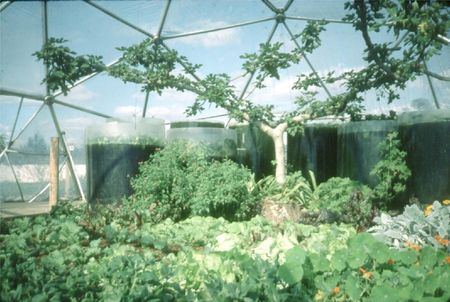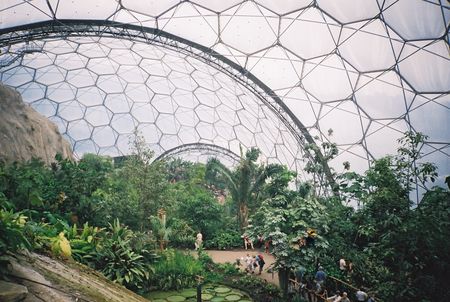Fluoropolymers: Difference between revisions
mNo edit summary |
(edits to image text, also link inserted: J. Baldwin Pillow Dome; additional links) |
||
| Line 1: | Line 1: | ||
[[File:Pillowdome.JPG|thumb|right|450px|Pillow | [[File:Pillowdome.JPG|thumb|right|450px|The [https://newalchemists.net/portfolio/pillow-dome/ Pillow Dome], built by [https://en.wikipedia.org/wiki/J._Baldwin Jay Baldwin] in the early 1980s, pioneered the concept of using inflated pillows made of Tefzel in three layers. It is pictured here in a 1980s image. Some trials were made with [https://en.wikipedia.org/wiki/Argon argon] as the inflating agent, leading to even better thermal insulation. The high, open interior space included tall fish pond (see [[Aquaponics|aquaponics]]), a large fig tree, and vegetable beds. The Ark housed a growing environment consisting of intensive organic gardens, irrigated by the "exhaust" from large, transparent tanks containing fish. The tanks also served as an effective heat sink, allowing an indoor climate warm enough to grow bananas in February, in New England, with no fossil fuel heat source (for more information on the Pillow Dome, see link below). The Pillow Dome pioneered the technology that was later used in the Eden Project.]] | ||
[[File:Eden project tropical biome.jpg|thumb|right|450px|Inside the tropical Biome at [https://en.wikipedia.org/wiki/Eden_Project Eden Project]: The covered biomes are constructed from a tubular steel (hex-tri-hex) with mostly hexagonal external cladding panels made from the thermoplastic ETFE. Glass was avoided due to its weight and potential dangers. The cladding panels themselves are created from several layers of thin UV-transparent ETFE film, which are sealed around their perimeter and inflated to create a large cushion. The resulting cushion acts as a thermal blanket to the structure.]] | [[File:Eden project tropical biome.jpg|thumb|right|450px|Inside the tropical Biome at [https://en.wikipedia.org/wiki/Eden_Project Eden Project]: The covered biomes are constructed from a tubular steel (hex-tri-hex) with mostly hexagonal external cladding panels made from the thermoplastic ETFE. Glass was avoided due to its weight and potential dangers. The cladding panels themselves are created from several layers of thin UV-transparent ETFE film, which are sealed around their perimeter and inflated to create a large cushion. The resulting cushion acts as a thermal blanket to the structure.]] | ||
| Line 10: | Line 10: | ||
==Uses== | ==Uses== | ||
* greenhouse covering (as foil) | * greenhouse covering (as foil) | ||
* corrosion-resistant containers and equipment | |||
==Related Links== | |||
* J. Baldwin in: The Journal of the New Alchemists (1981) [https://newalchemists.files.wordpress.com/2015/03/dome-as-village-component.pdf "A Dome Bioshelter as a Village Component"] | |||
* [http://www.americandurafilm.com/4-advantages-of-tefzel-etfe-film-for-a-greenhouse-covering/ "4 Advantages of Tefzel® ETFE Film for a Greenhouse Covering"] | |||
* BuildItSolar: [http://www.builditsolar.com/References/Glazing/DuPontFilms.htm "DuPont Plastic Film Glazing"] | |||
Revision as of 15:25, 11 May 2016


About
High-performance plastic materials such as PTFE ("Teflon") ETFE (Tefzel"). Very interesting properties such as UV resistance, elasticity, resistance to corrosion from most substances and better high temperature performance. Fluoropolymer foil is useful for things like greenhouse covering and for Aluminum Extraction From Clays. The UV resistance of these materials results in long life, with up to 30 years reported with minimal degradation.
Also, UV transmission leads to more "natural" light spectrum inside the greenhouse, suppressing microbes that may otherwise survive if UV light is blocked off. Fluoropolymers are slowly catching on as greenhouse covering but are still much more expensive than current alternatives such as polyethylene and polycarbonate. Drawbacks include high cost (10x that of polycarbonate), susceptibility to puncture holes and movement/wind, which is why fluoroplastic foil is often inflated as cushions (see images: "Pillow Dome" and "Eden Project"). Thicker membranes are possible but much more expensive.
Uses
- greenhouse covering (as foil)
- corrosion-resistant containers and equipment
Related Links
- J. Baldwin in: The Journal of the New Alchemists (1981) "A Dome Bioshelter as a Village Component"
- "4 Advantages of Tefzel® ETFE Film for a Greenhouse Covering"
- BuildItSolar: "DuPont Plastic Film Glazing"